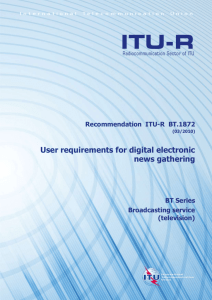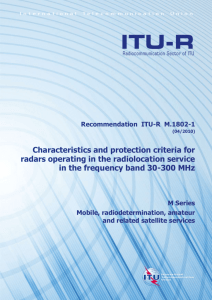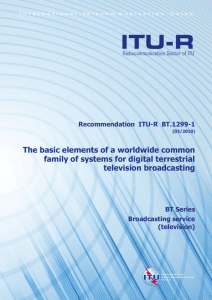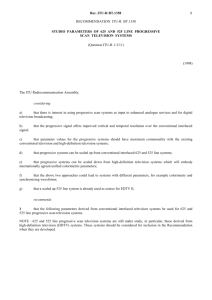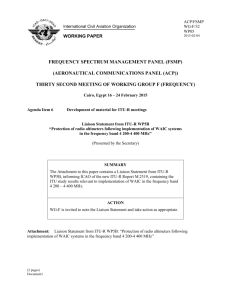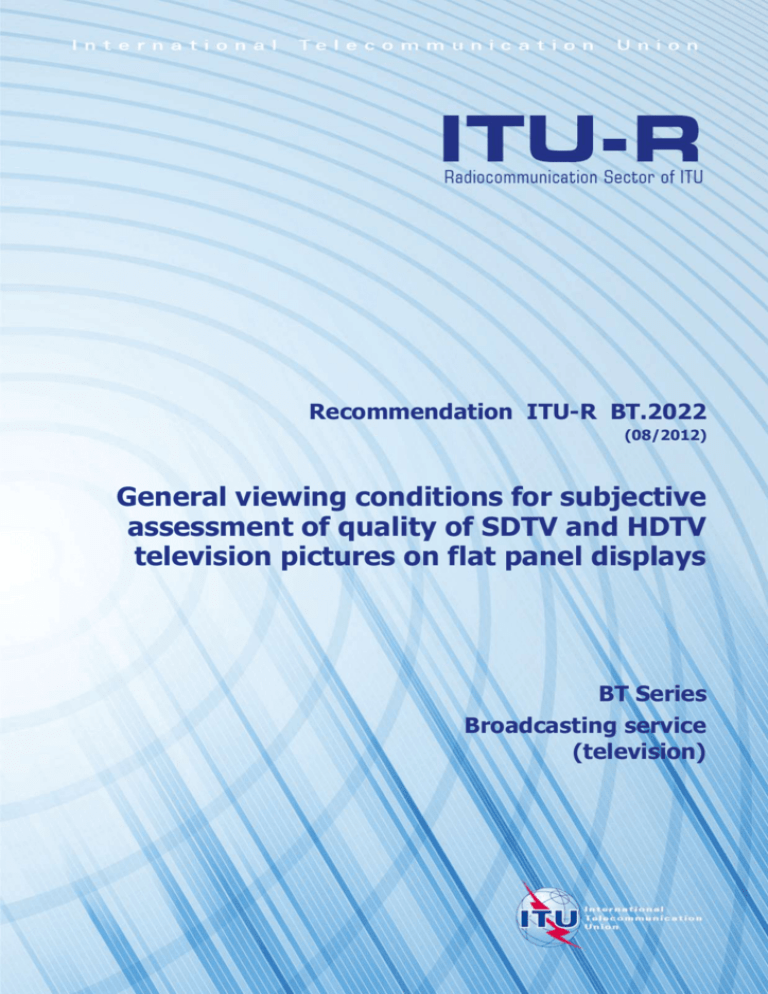
Recommendation ITU-R BT.2022
(08/2012)
General viewing conditions for subjective
assessment of quality of SDTV and HDTV
television pictures on flat panel displays
BT Series
Broadcasting service
(television)
ii
Rec. ITU-R BT.2022
Foreword
The role of the Radiocommunication Sector is to ensure the rational, equitable, efficient and economical use of the
radio-frequency spectrum by all radiocommunication services, including satellite services, and carry out studies without
limit of frequency range on the basis of which Recommendations are adopted.
The regulatory and policy functions of the Radiocommunication Sector are performed by World and Regional
Radiocommunication Conferences and Radiocommunication Assemblies supported by Study Groups.
Policy on Intellectual Property Right (IPR)
ITU-R policy on IPR is described in the Common Patent Policy for ITU-T/ITU-R/ISO/IEC referenced in Annex 1 of
Resolution ITU-R 1. Forms to be used for the submission of patent statements and licensing declarations by patent
holders are available from http://www.itu.int/ITU-R/go/patents/en where the Guidelines for Implementation of the
Common Patent Policy for ITU-T/ITU-R/ISO/IEC and the ITU-R patent information database can also be found.
Series of ITU-R Recommendations
(Also available online at http://www.itu.int/publ/R-REC/en)
Series
BO
BR
BS
BT
F
M
P
RA
RS
S
SA
SF
SM
SNG
TF
V
Title
Satellite delivery
Recording for production, archival and play-out; film for television
Broadcasting service (sound)
Broadcasting service (television)
Fixed service
Mobile, radiodetermination, amateur and related satellite services
Radiowave propagation
Radio astronomy
Remote sensing systems
Fixed-satellite service
Space applications and meteorology
Frequency sharing and coordination between fixed-satellite and fixed service systems
Spectrum management
Satellite news gathering
Time signals and frequency standards emissions
Vocabulary and related subjects
Note: This ITU-R Recommendation was approved in English under the procedure detailed in Resolution ITU-R 1.
Electronic Publication
Geneva, 2012
ITU 2012
All rights reserved. No part of this publication may be reproduced, by any means whatsoever, without written permission of ITU.
Rec. ITU-R BT.2022
1
RECOMMENDATION ITU-R BT.2022
General viewing conditions for subjective assessment of quality of SDTV and
HDTV television pictures on flat panel displays
(Question ITU-R 81-1/6)
(2012)
Scope
This Recommendation specifies general viewing conditions for subjective assessment of quality of SDTV
and HDTV television pictures on flat panel displays.
The ITU Radiocommunication Assembly,
considering
a)
that Recommendation ITU-R BT.500 has been developed assuming the use of CRT
displays in subjective assessment;
b)
that the transition from CRT to non-CRT display imposes the use of non-CRT displays for
subjective assessment;
c)
that the picture rendering characteristics may differ between CRT and non-CRT displays;
d)
that increasingly SDTV and HDTV flat panel displays (FPDs) are being used for subjective
quality assessment of television pictures,
recognizing
a)
that Recommendations ITU-R BT.814 and BT.815 provide specifications and alignment
procedures for setting of brightness and contrast of displays;
b)
that Recommendation ITU-R BT.1848 provides guidelines on safe areas of 625-line,
720-line and 1 080-line formats of wide-screen 16:9 aspect ratio digital productions;
c)
that Recommendation ITU-R BT.1886 specifies the reference electro-optical transfer
function (EOTF) that the displays used in HDTV programme production should follow in order to
facilitate consistent picture presentation;
d)
that Report ITU-R BT.2129 investigates user requirements for a flat panel display as a
master monitor in an HDTV programme production environment,
noting
1
that specific viewing conditions for subjective assessments of specific systems are given in
the related Recommendations (e.g. Recommendation ITU-R BT.710 for the HDTV and
Recommendation ITU-R BT.1129 for SDTV);
2
that Recommendations ITU-R BT.710 and BT.1129 came into force before the
development of wide screen flat panel displays,
recommends
1
that the general viewing conditions described in Annex 1 should be used for subjective
assessment of picture quality.
2
Rec. ITU-R BT.2022
Annex 1
1
General viewing conditions
Different environments with different viewing conditions are described.
The laboratory viewing environment is intended to provide critical conditions to check systems.
General viewing conditions for subjective assessments in the laboratory environment are given
in § 1.1.
The home viewing environment is intended to provide a means to evaluate quality at the consumer
side of the TV chain. General viewing conditions in § 1.2 reproduce a home environment. These
parameters have been selected to define an environment slightly more critical than the typical home
viewing situations.
Some aspects relating to the monitor characteristics are also discussed.
1.1
General viewing conditions for subjective assessments in a laboratory environment
The assessors’ viewing conditions should be arranged as follows:
a)
Room illumination:
b)
Chromaticity of background:
c)
Peak luminance1:
low
D65
70-250 cd/m2
(See § 1.7.2)
0.02 (See § 1.7.1)
d)
Monitor contrast ratio:
e)
Ratio of luminance of background behind picture monitor to peak 0.15
luminance of picture:
1.2
a)
General viewing conditions for subjective assessments in a home environment
Environmental illuminance on the screen (incident light from the
environment falling on the screen, should be measured
perpendicularly to the screen):
200 lux
1
Peak luminance :
70-500 cd/m2
(See § 1.7.2)
Ratio of luminance of inactive screen to peak luminance monitor 0.02 (See § 1.7.1)
contrast ratio:
b)
c)
1.3
Viewing distance
The viewing distance is based on the screen size and it can be selected according to two distinct
criteria: the preferred viewing distance (PVD) and the design viewing distance (DVD). The
selection of one or the other of the two criteria will depend upon the purpose of the study.
1.3.1
Preferred viewing distance
The preferred viewing distance (PVD) is based upon viewers’ preferences which have been
determined empirically. The PVD (in function of the screen sizes) is shown in Fig. 1, which
contains a number of data sets collected from available sources. This information may be referred to
for designing a subjective assessment test.
1
Peak luminance should be adjusted according to the room illumination.
Rec. ITU-R BT.2022
3
FIGURE 1
Preferred viewing distance in function of the screen sizes
12
Ohtani 1970
Nathan 1985
PVD in picture heights (H)
10
Lund 1993
Ardito 1994
8
Narita 2001
Tanton 2004
6
Kubota 2006
Fujine 2008
4
Kobayashi 2008
Suzuki 2011
2
Kusakabe 2012
0
0
20
40
60
80
100
120
140
160
Screen size (inch)
BT.2022-01
1.3.2
Design viewing distance
The design viewing distance (DVD), or optimal viewing distance, for a digital system is the
distance at which two adjacent pixels subtend an angle of 1 arc-min at the viewer’s eye; and the
optimal horizontal viewing angle as the angle under which an image is seen at its optimal viewing
distance.
Table 1 reports the optimal viewing distances (and optimal horizontal viewing angles) for several
image resolution systems expressed in multiples of the picture’s height.
TABLE 1
Optimal horizontal viewing angle, optimal viewing distance in picture heights (H)
Image
system
Reference
Aspect
ratio
Pixel
aspect
ratio
Optimal
horizontal
viewing angle
Optimal
viewing
distance
720 483
Rec. ITU-R BT.601
4:3
0.89
11°
7H
640 480
VGA
4:3
1
11°
7H
720 576
Rec. ITU-R BT.601
4:3
1.07
13°
6H
1 024 768
XGA
4:3
1
17°
4.5 H
1 280 720
Rec. ITU-R BT.1543
Rec. ITU-R BT.1847
16:9
1
21°
4.8 H
1 400 1 050
SXGA+
4:3
1
23°
3.3 H
1 920 1 080
Rec. ITU-R BT.709
16:9
1
31°
3.2 H
3 840 2 160
Rec. ITU-R BT.1769
16:9
1
58°
1.6 H
7 680 4 320
Rec. ITU-R BT.1769
16:9
1
96°
0.8 H
4
1.4
Rec. ITU-R BT.2022
Observation angle
The maximum observation angle relative to the normal should be constrained so that deviations in
reproduced colour on the screen should not be visible to an observer. The optimal horizontal
viewing angle of an image system under test should also be considered to determine the observation
angle.
1.5
Monitor processing
Monitor processing such as image scaling, frame rate conversion, image enhancer, if implemented,
should be done in such a way as to avoid introducing artefacts. A test report should indicate whether
de-interlacer is used or not for interlaced signals. It is preferable not to use de-interlacer if interlaced
signals can be displayed without it.
1.6
Monitor resolution
The resolution of professional monitors usually complies with the required standards for subjective
assessments in their luminance operating range.
To check and report the maximum and minimum resolutions (centre and corners of the screen)
at the used luminance value might be suggested.
If consumer FPD TV sets are used for subjective assessments, it is strongly recommended to check
and report the maximum and minimum resolutions (centre and corners of the screen) at the used
luminance value.
At present the most practical system available to subjective assessments performers, in order to
check monitors or consumer TV sets resolutions, is the use of a swept test pattern electronically
generated.
1.7
Monitor adjustment
Brightness and contrast of a monitor should be adjusted under the environment illuminance by
using the PLUGE waveforms in accordance with Recommendation ITU-R BT.814.
The monitor contrast ratio should be measured in accordance with Recommendation
ITU-R BT.815.
1.7.1
Monitor contrast
Contrast could be strongly influenced by the environment illuminance.
Professional monitors seldom use technologies to improve their contrast in a high illuminance
environment, so it is possible they do not comply with the requested contrast standard if used in a
high illuminance environment.
Consumer monitors typically use technologies to get a better contrast in a high illuminance
environment.
1.7.2
Monitor brightness
When adjusting the LCD monitor brightness, it is preferable to use backlight intensity control rather
than using signal level scaling to retain the bit precision. In the case of other display technologies
that do not use a backlight, the white level should be adjusted by means other than signal level
scaling. Note that PDP controls the brightness by the number of light radiations, and if lower
brightness is set, tone reproduction will be degraded.
Rec. ITU-R BT.2022
1.8
5
Monitor motion artefacts
The display should not introduce motion artefacts that are introduced by specific display
technologies. On the other hand, the motion effects included in the input signal should be
represented on the display.
1.9
Monitor characteristics in general
Note that using different characteristics of monitors would yield different picture quality. Thus, it is
strongly recommended that characteristics of the monitors used should be checked beforehand.
Recommendation ITU-R BT.1886 – Reference electro-optical transfer function for flat panel
displays used in HDTV studio production and Report ITU-R BT.2129 – User requirements for a
Flat Panel Display (FPD) as a Master monitor in an HDTV programme production environment
may be referred to when professional FPD monitors are used for subjective assessment.
1.10
Safe areas of wide-screen 16:9 aspect ratio SDTV and HDTV picture displays
Safe areas for 625, 720 and 1080 line picture displays are provided in Recommendation
ITU-R BT.1848.
_____________




